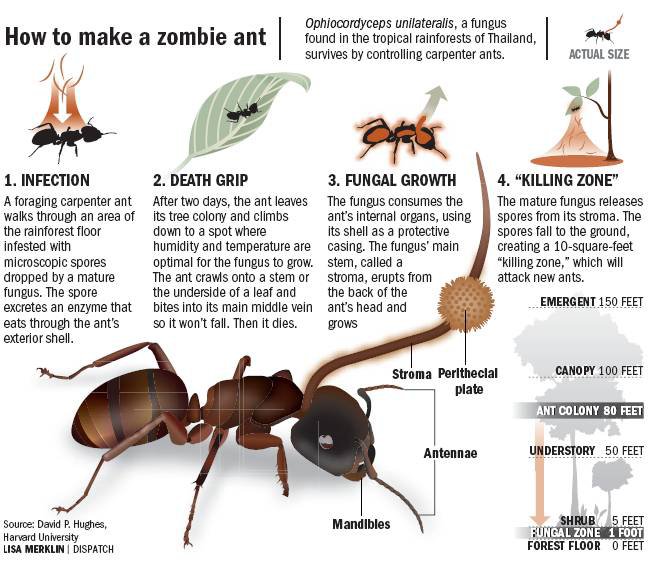Reproduction and Life History
The life cycle of Ohiocordyceps unilateralis can be
divided into approximately four parts: infection, death grip, stalk growth,
and dispersal.
 Fungal spores of O. unilateralis specifically target host
ants of the species Camponotus leonardi foraging on the forest floor.
Observations conclude that spores attach to the cuticle of a target ant and
secrete digestive enzymes to break through the exoskeleton and begin
infecting the host (Evans, et al., 2011). Yeast-like growth within the host progresses until the
manipulation of the host by the fungal parasite causes the host ant to fall
from the canopy to a lower elevation optimal for fungal growth. Further
manipulation by the host directs the ant to a leaf, whereupon the ant is
cued to bite the middle vein in a characteristic death-grip like form
preventing the ant from falling. Following the ant’s death, further growth
consumes the ant’s internal tissue while maintaining a protective
exoskeleton on the outside (Evans, et al. 2011). The characteristic growth of the fungal stalk
(stroma) from the base of the neck, eventually develops into a mature fungal
body capable of releasing spores. Spores released complete the cycle until
an unfortunate ant below becomes the target and begins the cycle yet again.
Fungal spores of O. unilateralis specifically target host
ants of the species Camponotus leonardi foraging on the forest floor.
Observations conclude that spores attach to the cuticle of a target ant and
secrete digestive enzymes to break through the exoskeleton and begin
infecting the host (Evans, et al., 2011). Yeast-like growth within the host progresses until the
manipulation of the host by the fungal parasite causes the host ant to fall
from the canopy to a lower elevation optimal for fungal growth. Further
manipulation by the host directs the ant to a leaf, whereupon the ant is
cued to bite the middle vein in a characteristic death-grip like form
preventing the ant from falling. Following the ant’s death, further growth
consumes the ant’s internal tissue while maintaining a protective
exoskeleton on the outside (Evans, et al. 2011). The characteristic growth of the fungal stalk
(stroma) from the base of the neck, eventually develops into a mature fungal
body capable of releasing spores. Spores released complete the cycle until
an unfortunate ant below becomes the target and begins the cycle yet again.
Recent analysis of 48 million year old leaves of Messel, Germany by
researchers David P. Hughes, Torsten Wappler and Conrad C. Labandeira led to
the discovery of biting patterns typical of infected host ants by the
parasitic fungus Ophiocordyceps unilateralis (Hughes, et al. 2010). This research is notable
both in that it suggests historic biogeographic parallels between
mid-eastern Europe and recent Southeast Asia, but also in that it suggests
the past history of O. unilateralis.
Ophiocordyceps unilateralis requires few but critical conditions in order to
transition from hyphal growth to the formation of a stroma.
It is interesting to think that the fungus knows that any death inside the
ant colony will lead to its removal by other worker ants that perceive a
threat to the colony (BBC America 2006). As a result, observations of infected ants have shown
that they will periodically fall from leaves to a lower portion of the tree
canopy optimal for fungal growth and away from other ants. The
synchronization of leaf biting around the noon hour as observed by
researchers is evident of clock genes being expressed by O. unilateralis
(Hughes, et al. 2011).
The use of clock genes in addition to the “drunkards walk” of infected ants
by O. unilateralis suggests that these are critical steps in directing the
host towards a location suited for optimal growth.
